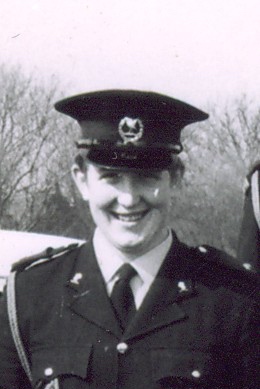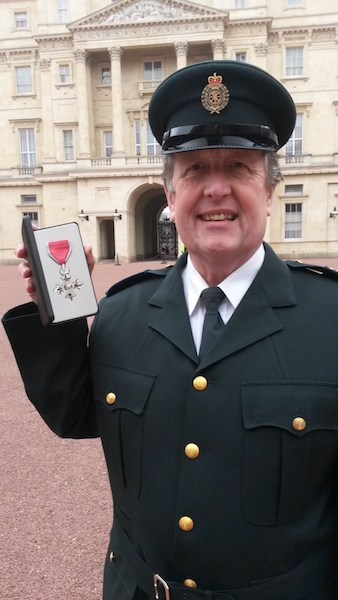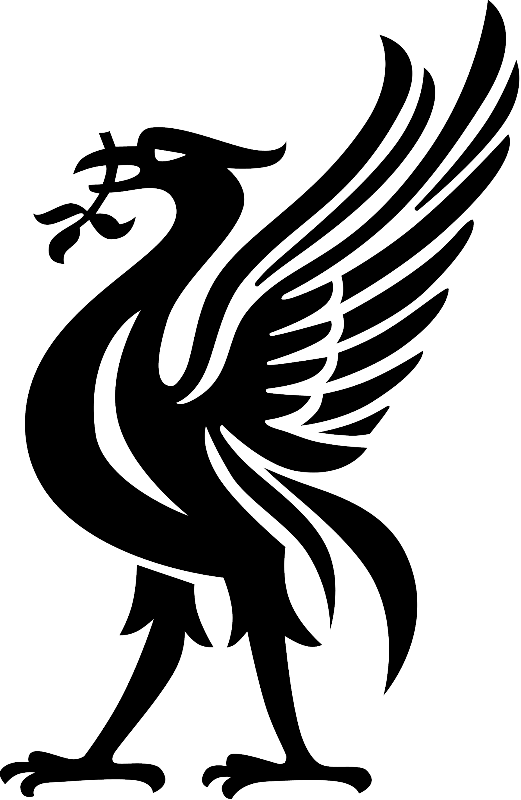Memories of Cadets, a man called Cowpie, messroom humour and an MBE
Steve Evans MBE.

In 1971 I was taken on as a young lad straight from school joining as an Ambulance Cadet. That Cadetship lasted some two and a half years and through great training and mentorship it helped shape me into a health care professional who genuinely possessed both the skills and desire to help save life and reduce patients suffering. This foundation stone of wanting to help that patient who was trusted to my care for that “golden hour” stayed with me throughout my 44 years of public service.
I passed out from the Cadets in 1973 with a confidence and self-belief that had changed that young lad straight from school in a way that I had not though possible. I had qualified as a Fellow of the Institute of Certified Ambulance Personal (FICAP) and developed a great grounding and common sense approach that would help me respond to and deal with any patients cry for help. Fundamental to that change was the Cadet Training officers of the day who were Harry Jones and Wally Potts to whom I have always been thankful.
I was initially based at Anfield station and the great mess room humour of an Ambulance Service wasn’t long in nicknaming me “cowpie” after the comic strip character “Desperate Dan”. This nickname has stayed with me for 40 plus years and my younger brother who joined the service 3 years later being half my width soon earned the nicknamed “Mince Pie”. The banter of mess room humour is something that I have missed since I have retired and I recognise its importance in helping us get through each and every shift whether they be good or bad ones.
The way you progressed in the City of Liverpool Ambulance Service was you started working days taking patients to clinics and day centres and did the odd 999 call when free. This progressed to working shifts on 999 calls and urgent admissions. This progression seemed so logical in that it gave you a natural stepped platform to learn to talk to patients and fellow Health Care Professionals. It also gave you the street knowledge that you had to have in the days when there were no computers or Sat Nav’s to help guide you to incidents. I worked at a variety of city stations before arriving at Stanhope Street Toxteth, which was filled with characters some long gone.
Liverpool in the 1970’s was a different place than the modern tourist City of today. It had struggled in the post war years and we were surrounded by tenement blocks such as Carl Gardens, Sir Thomas White Gardens, Gerard Crescent, Hurst Gardens etc. These were multi storey tenements with “E” landings and no lifts and very awkward staircases. Carrying patients was extremely physical so you became very strong very quickly. Another great example of mess room humour was where I met the condition “Tachycarpeture” which was used to describe how your boots stuck to the floor of some of the post war slums. It was a great moment for Ambulance Staff when the post war tenements were knocked down in the slum clearances. It is difficult to express how difficult moving poorly patients from these places was and it was only in the early 1970’s that that carry chair was invented. Prior to that staff used what was known as a blanket lift which was not the easiest or safest thing to do
This foundation stone of wanting to help that patient who was trusted to my care for that “golden hour” stayed with me throughout my 44 years of public service.
My core standard - Steve Evans MBE
Ambulance Aid was simple and based on basic first aid principles. The ambulance had woollen blankets and bandages same as those issued during the second world war. Airway management was achieved through the use Brookes Airways which started to be replaced by the Minuteman resuscitator. This was a revolution and the patient’s relatives used to be in awe of this machine which made wonderful noises like the Wizard of Oz’s machine.
What I vividly recall is that the introduction of higher training standards for technician training in 1966 with what was known as the Millar Qualification; was slowly but surely changing people’s attitudes to the importance of the role that the ambulance service could play in pre-hospital care. Equipment was being developed and we started to see the arrival of now everyday items such as the scoop orthopaedic stretcher and we were allowed to carry and administer Entonox pain relief gas. Efforts were being made to train Ambulance Staff to a higher standard with the A & E Consultant of Broadgreen Hospital Doc Allen playing an early pivotal role with staff such as Peter Hanton undergoing advanced ambulance aid training.
What I vividly recall is that the introduction of higher training standards for technician training in 1966 with what was known as the Millar Qualification; was slowly but surely changing people’s attitudes to the importance of the role that the ambulance service could play in pre-hospital care. Equipment was being developed and we started to see the arrival of now everyday items such as the scoop orthopaedic stretcher and we were allowed to carry and administer Entonox pain relief gas. Efforts were being made to train Ambulance Staff to a higher standard with the A & E Consultant of Broadgreen Hospital Doc Allen playing an early pivotal role with staff such as Peter Hanton undergoing advanced ambulance aid training.
Being a Paramedic began to make a massive difference to the way I thought and acted.
Steve Evans MBE

That group of four pioneers were Dave Buckley (retired), Ray Lunt, Ken Morgan and Steve Noonan (retired). What we all started to see was ambulance staff delivering extended skills including defibrillation that was truly making a difference to patient’s survival. I along with many others wanted to become a paramedic.
In 1989 I was given the opportunity to attend a Paramedic Course. I recall how daunting it was as I had no O levels and had been out of the learning environment for 17 years, so I had to learn how to learn. I was determined to succeed and the long study hours and sweaty palms when you had to complete practical assessments in front of eminent hospital consultants all paid off.
In 1989 I was awarded my Paramedic Qualification and I was so proud when I was presented with my own bright orange Ambu Resuscitation kit. For the second time in my career I had achieved a fundamental change which I had not thought possible; and fundamental to that change was my Paramedic Instructor Ray Lunt.
Being a Paramedic began to make a massive difference to the way I thought and acted. It is amazing to think that every now and again you can really make a difference to a patient’s life, when you pick them up in a collapsed condition with no blood pressure and a very slow heartbeat and know if you do not give them the right treatment they will die before you get to hospital.
Every time I enter a modern day ambulance I take a quiet moment and I am reminded of how our role has changed over the decades. It is the turn of the new generation of staff to help continue that change for the betterment of the patient.
I also began to better appreciate the importance of the training officer in our careers and how they help shape the future and impact by cascade on many groups of people. I knew that over my career I had graduated through the University of Life and developed a vast portfolio of knowledge and experience. Experience that I should use and pass on and use I did by becoming an instructor myself. Another great opportunity all brought about by a chance given to a young lad straight out of school.
The opportunities that an Ambulance Career has given have been fantastic with the key ones that I am truly appreciative of being:-
• In 1996 I started to write and was published in the British Medical Journal and had articles on major trauma and aortic aneurysms and I wrote a published a book “A Guide through the Maze of ECG’s” how to read heart rhythms.
• In 2010 I wrote a cycling first aid E book which has had 2.7 million re-tweets via Twitter@paramedicsteve
• My biggest achievements have been my Alcohol Harm Reduction Campaign called “Don’t Walk Away and Leave a Friend to DIE”, this campaign is now World-wide and is on the Times Educational Supplement website as a free download
• December 2015 I was honoured with an MBE for my services to First Response and my youth work. An honour that was truly the Cherry on the cake to finish off a most enjoyable career.
In ending my career snapshot it is very easy to focus on the negative things and recall the bad jobs that we have all gone to. I would like to end on a high by recounting the fact that I have delivered 19 babies in some challenging places and circumstances including one on Christmas day in the back of the Ambulance on Queens Drive just outside the Jolly Millar pub. Weirdly 12 years later, a girl in the back of the ambulance said to me “I was born in the back of an Ambulance on Christmas Day” I said I bet your name is Lee-Anne, she said “Yes how do you know”, I said because I delivered you.
At my retirement speech I said that I have had a blast and if I could do it all again I would. I truly mean that and I have no hesitation in recommending a career in pre-hospital care to anyone who is reading this.
Radio Merseyside came along and spoke to Steve on his last day.
Here is the recording of the interview which we feel is a very touching tribute to someone who has given 44 years of loyal and dedicated public service.
Here is the recording of the interview which we feel is a very touching tribute to someone who has given 44 years of loyal and dedicated public service.
Every time I enter a modern day ambulance I take a quiet moment and I am reminded of how our role has changed over the decades. It is the turn of the new generation of staff to help continue that change for the betterment of the patient.
Steve Evans MBE.
The banter of mess room humour is something that I have missed since I have retired.
Steve Evans MBE
